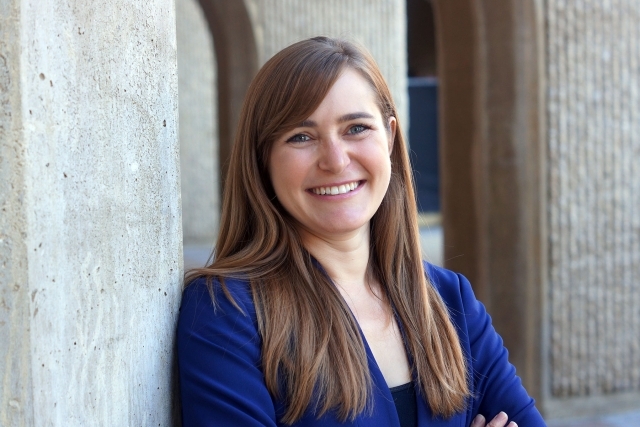
Erin Fahle, who has a doctor of philosophy degree in Education Policy, an Assistant Professor in Department of Administrative and Instructional Leadership collaborated with Stanford Professor Sean Reardon; Andrew Ho, Ph.D., Harvard University; and Ben Shear, Ph.D., CU Boulder. The Educational Opportunity Project at Stanford is a free online tool that allows journalists, educators, parents and policymakers to explore student test scores and trends nationwide, including achievement gaps by race, poverty level and gender. It is supported by grants from the U.S. Department of Education’s Institute of Education Sciences, the Spencer Foundation, the William T. Grant Foundation, the Bill and Melinda Gates Foundation and the Overdeck Family Foundation
The findings were released on Sept. 23 in a paper accompanying the launch of a new interactive data tool from the Educational Opportunity Project at Stanford University, an initiative directed by Reardon to support efforts to reduce educational disparities throughout the United States. This new public website shares data on the landscape of educational opportunity of elementary and middle school students in schools, district, and counties across the U.S.
“Using this website, everyone- parents, educators, policy-makers, and researchers- has the ability to explore the landscape of educational opportunity in US schools and communities. Making high-quality information accessible and interactive will hopefully spark new conversations, with new voices, about educational disparities and social policy,” says Fahle.
The Stanford Education Data Archive (SEDA), first made available online in 2016 in a format designed mainly for researchers, is built from 350 million reading and math test scores from 3rd to 8th grade students during 2008-2016 in every public school in the nation. It also includes district-level measures of racial and socioeconomic composition, segregation patterns, and other educational conditions.
Now, with an interactive tool on the Educational Opportunity Project’s website, any user can generate charts, maps and downloadable PDFs to illustrate and compare data from individual schools, districts or counties. (Visualizations also can be embedded elsewhere online so that users can access them directly from another site.)
The site provides detailed data on three measures of educational opportunity: (1) average test scores, which reflect all of the educational opportunities children have from birth through middle school; (2) learning rates (how much students learn from one year to the next), which reflect the opportunities available in their schools; and (3) trends in how much average test scores change each year, which reflect changes in the opportunities available to successive cohorts of children.
“We can also break it down and look at how students are performing differentially by race, by ethnicity, by gender, by family income,” said Reardon. “That lets us understand not just how a community is providing opportunity for everyone, but whether it’s providing the same amount of opportunity for children from different backgrounds.”
Underlying the website’s opportunity explorer and research papers is a database that the team built over the past six years, containing educational testing data and contextual data. Fahle and the other team members used this data to write numerous papers to better understand factors that shape students’ educational experiences, as well as the systematic differences in students’ opportunities based on race, income and gender. The most recent of these papers examines the impact and extent of school segregation in the U.S.
Fahle points out the pertinence of this launch, particularly around the issues that are frequently debated in New York City. “Our work shows that racial segregation is pervasive and, through concentrating minority students in high poverty schools, has serious academic consequences for black and Hispanic students. This information is timely and underscores the importance of on-going conversations about segregation- including the one taking place in New York City public schools.”
We’re hoping that by providing public access to this information in a more user-friendly format we will not only help to inform a broader audience, but also to spark new conversations and research about educational equity,” Fahle said.
Beyond learning about their own school or districts, users can also find and learn from comparable communities with fewer inequities. For instance, superintendents concerned about the achievement gap between students of different race and ethnicity in their district could use the tool to identify other districts around the country that are similar in size and demographics but have smaller achievement gaps—and then reach out to leaders in those communities to find out about the practices and policies that have been effective.
“We have momentum,” notes Fahle, “the critical next step is to reflect on how policies and programs exacerbate or reduce segregation in our schools.”
The project’s development team includes Andrew Ho, PhD ’05, professor at Harvard Graduate School of Education, Erin Fahle, PhD ’18, assistant professor at St. John’s University School of Education; and Benjamin Shear, PhD ’18, assistant professor at University of Colorado.
Coauthors of the research paper on school segregation are Ericka S. Weathers, PhD ’18, an assistant professor at Penn State College of Education; Erin M. Fahle, PhD ’18, an assistant professor at St. John’s University School of Education; Heewon Jang, a doctoral student at Stanford GSE; and Demetra Kalogrides, a research associate with the Center for Education Policy Analysis (CEPA) at Stanford GSE.
Adapted from Carrie Spector
by Steven M. Neier
Related News
Dean Jerrold Ross Conference Room Unveiled
On Tuesday, December 10, the newly renovated conference room on the fifth floor of Sullivan Hall was dedicated in honor of Jerrold Ross, Ph.D., former Dean of The School of Education . The renovation...
Institute for Catholic Schools Provides Educational Resources to Local Catholic School
The Institute for Catholic Schools (ICS) in The School of Education at St. John’s University recently donated approximately $2,800 worth of academic and sensory learning tools to Father Vincent...
Meet Anna R. Lukachik ’80Ed, Pietas Medal Recipient
At St. John’s University’s annual Alumni Convocation on October 18, Anna R. Lukachik ’80Ed received the Pietas Medal, an award that honors exceptional alumni for their service and achievements...
